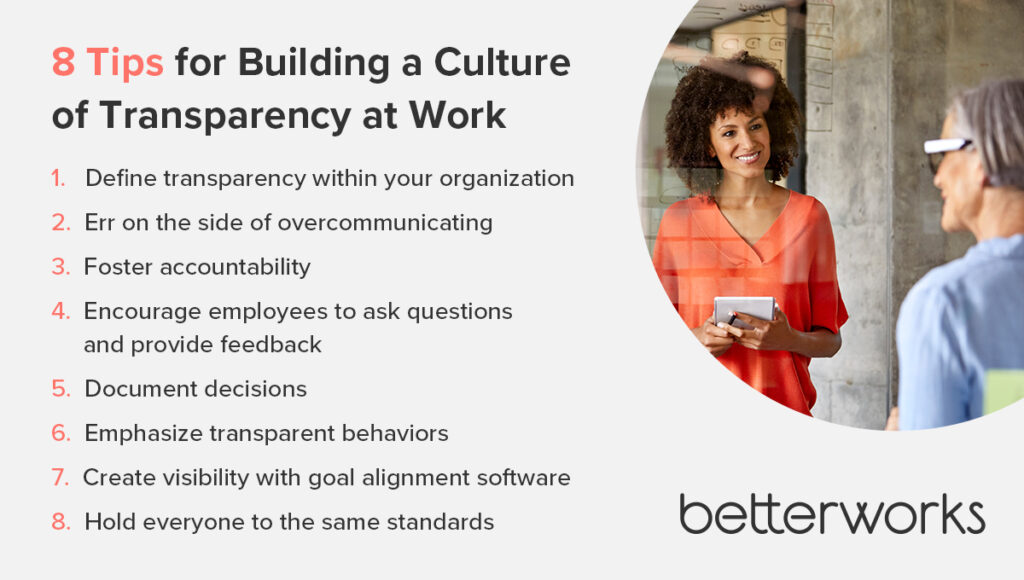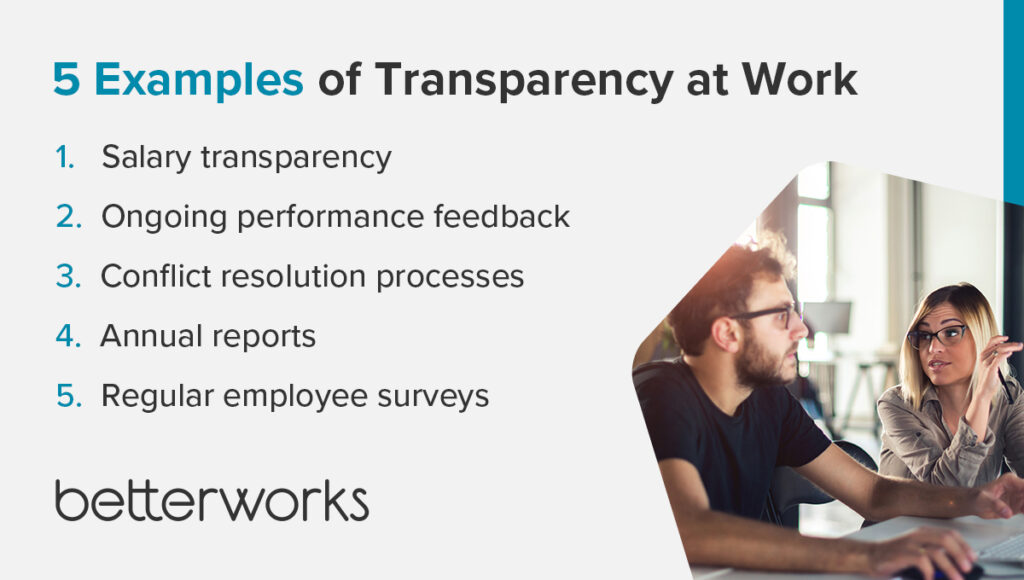Transparency helps everyone in the workforce understand the current state of the business, the strategy, and how every employee can contribute. When you have these conditions, your workforce becomes more engaged and effective. That’s why promoting transparency in the workplace should be a priority for every HR leader.
According to Gallup’s 2023 State of the Global Workplace report, 41% of employees who are “quiet quitting” cited aspects of engagement or culture as their primary reason. Many of those employees would be more engaged if there was more transparency at work. Examples include approachable and communicative managers, clearer goals, and more guidance from leaders.
Without a transparent work environment, employees will have a hard time trusting leaders or understanding the company’s vision. Less trust means less engagement, collaboration, and job satisfaction.
Discover what transparency in the workplace is, why it matters, and how you can cultivate a transparent work culture.
What is workplace transparency?
Many companies list transparency as a core value. But what does that look like in the workplace? While the specifics may differ, here are common indicators of a transparent work culture.
Clarity on company goals
In a transparent organization, everyone in the workforce understands company strategy and objectives. Goals are clear, visible, and in strategic alignment at every level of the company.
Transparency means employees can see what their peers are working on and how their work affects the rest of the organization. This knowledge can help employees prioritize and execute their tasks more effectively while finding opportunities to help their colleagues. In an opaque culture, people might struggle to understand their work, much less that of their colleagues.
Increased goal clarity also improves each employee’s sense of purpose because they can see how their efforts drive business results, in turn promoting engagement and retention.

Drive transparency with goal-setting. Learn more.
Accountability and ownership at all levels
In a highly transparent organization, there’s no murkiness about who owns goals and business outcomes.
This type of transparency connects every task to a bigger goal, even if it’s just supporting another task within a project. Each task must connect to an objective with an owner who’s held accountable for results. By assigning ownership, leaders can easily track progress, reward success, and quickly identify problems. Project management software like Asana and its alternatives are especially effective at assigning ownership to tasks and showing the bigger picture at a glance.
Transparency and accountability feed into your larger commitment to agility and continuous improvement. When you recognize that something isn’t working, you can quickly act to solve it.
Open and honest communication
In a transparent company, communication is open and honest. When goals are visible and tasks have clear ownership, everyone can see who’s responsible for what. Leaders and managers can ask targeted questions and expect satisfactory answers from each objective’s owners.
When transparency is paired with collaboration, employees at every level are encouraged to surface problems, whether it’s something they’re struggling with or to offer feedback or assistance to co-workers.
When workers know they can ask for help and get it, they’re less likely to persist with bad results or processes, especially when they can incorporate constructive and continuous feedback. Because each project is easily visible, managers can jump right into problem-solving mode without requiring an extensive briefing.

Why transparency in the workplace matters
In a transparent workplace culture, employees understand the organization’s expectations and goals, as well as their own. This clarity helps them work more efficiently.
Transparency also allows for better decision-making because employees can see how their decisions will affect their teammates and the company. Adopting transparent communication practices, meanwhile, can create a positive loop. Transparency fosters trust between employees and managers, which leads to better communication and collaboration, which increases trust. Effective collaboration, meanwhile, can increase employee satisfaction, engagement, and productivity.
8 tips for building a culture of transparency at work
To leverage the benefits of transparency in your business, you need to cultivate it in your company culture. Here are eight steps you can take to encourage transparency at your company.
Define transparency within your organization
Transparency looks different in every organization, so don’t rely on generic definitions. Define transparency in terms of specific norms and behaviors so employees can visualize what you expect from them, how they can apply it, and how to hold each other accountable.
To align employees with company values, provide examples of transparent behaviors within your job descriptions, standard operating procedures, and code of conduct. For example, you might expect project managers to present detailed progress reports in weekly standup meetings. These reports might include milestones, challenges, and changes in timelines or scope.
Be sure to clearly define transparency in terms of workplace ethics. Consider a scenario where a company discovers a data breach that exposes sensitive customer information. The ethical choice is to be transparent while following applicable laws and regulations. Usually, the company should promptly inform affected customers about the breach, share how it’s responding, and advise customers on next steps. Without transparency, by contrast, employees might try to hide evidence of a breach from customers and regulators.
When employees understand what you mean by transparency at work, they’ll have an easier time adhering to your standards.
Err on the side of overcommunicating
It’s better to overcommunicate with employees than leave anyone feeling uninformed. Without transparent communication, employees won’t trust you — and that’ll likely translate to lower productivity and engagement.
Start with a targeted communication plan for sharing business updates at a high level. Looping employees in on big organizational news helps them feel informed and trusted. All-hands meetings and employee newsletters are just a couple of ways to deliver this type of communication.
From there, set standards for communication down the org chart. This includes cascading communication from leaders and managers, teamwide updates, and other important updates. You can set norms for what, when, and how to communicate with employees, including what channels to use. Make sure to create space for employees to deliver feedback and ask questions.
Foster accountability
Every activity, task, or initiative in your organization should have an owner. Otherwise, accountability will be hard to come by. Team leaders and executives are ultimately accountable for performance, but project- and task-level ownership increases transparency around who is doing what and what outcomes are expected.
Review the habits of high-reliability organizations, many of which hold executives accountable and delegate down from there. While accountability starts high, every level of the organization is responsible for outcomes.
Build clear ownership into your daily processes. Project managers can help define and structure this type of accountability within each team. If you have daily standups or check-ins, use them to review open assignments, declare objectives, and track progress against goals.
Encourage employees to ask questions and provide feedback
In a transparent organization, communication flows up, too. Employees need to feel safe asking questions and providing feedback to managers and leaders.
A transparent culture empowers line workers to follow up with their manager or project leader if they encounter obstacles they can’t confidently address. If an employee isn’t sure how to prioritize their tasks, for example, they should feel comfortable seeking clarity.
Transparent, two-way communication also applies at the organization level, whether through dedicated feedback channels, all-hands meetings, or the use of employee survey software to get on-the-ground perspectives.
Document decisions
Transparent and accountable workplaces default to documenting important workplace discussions and decision-making. HR leaders can establish policies for when and how to chronicle decisions. Don’t just document the decision; also record the rationale.
This type of transparency can help employees understand why decisions were made and how similar situations have been handled historically.
Emphasize transparent behaviors
Transparent behaviors include being open to feedback, communicating clearly and honestly, and defaulting to sharing information.
To foster these behaviors, HR leaders and managers should lead by example — providing a safe and trusting environment where employees feel comfortable expressing their ideas and opinions. Additionally, recognize and reward employees who display transparent behaviors.
Create visibility with goal alignment software
A culture of transparency, alignment, and trust depends on greater visibility into where each person falls in the company structure. It’s challenging to communicate goals across the company if employees aren’t familiar with organizational charts.
To foster transparency, you need goal alignment software to ensure that roles and reporting structures are visible to everyone. When employees can see each other’s goals and job role, they have a better understanding of what their colleagues are trying to do and why it matters for organizational goals. Progress is also easier to track, whether for the employee, team leads, or the C-suite.
Hold everyone to the same standards
Transparency makes it more difficult to treat people subjectively and unfairly. HR leaders can ensure that performance reviews are conducted fairly and objectively, for example, and that assessments are based on job-relevant criteria.
Create a culture of open communication, trust, and respect that applies equally to everyone, regardless of job title, role, or characteristics.

Managers as advocates of transparency at work
While executives can set the tone for transparency, and HR leaders set the policies, managers play a pivotal role in creating day-to-day transparency in the workplace. They are the bridge between senior leadership and front-line employees, and their example will determine whether your workforce embraces transparency or merely pays lip service.
Effective managers empower their employees to be open, honest, and respectful with each other. This manifests in sharing best practices, communicating updates, admitting mistakes, and seeking feedback. When managers show that these behaviors are accepted and encouraged, employees will follow. The result is transparency that feels natural, because it’s simply the way things are done.
Effective managers create an environment where employees feel comfortable voicing their opinions, concerns, and ideas. This can occur in one-on-one meetings, team discussions, or shared communication channels. Managers add to this flow by having regular employee check-ins, actively listening, and addressing issues promptly.
Another way managers make transparency real is by having honest conversations about career development with their employees. They discuss opportunities for growth, the skills needed to advance, and potential career paths within the organization. This transparency supports performance improvement and helps employees understand what they need to do to fulfill their long-term career aspirations.
Betterworks’ 2023 State of Performance Enablement report revealed that employees who are “always or very satisfied” with their career development are up to 28 percentage more likely to say they are always engaged and 24 percentage points more like to say they are always productive than employees who say they are somewhat satisfied with the career development conversations.
5 great examples of transparency in the workplace
Transparency at work is a cornerstone of healthy and thriving organizations. It fosters trust, collaboration, and open communication — resulting in increased employee satisfaction. Check out these examples to inspire your culture.
Salary transparency
Companies practice salary transparency when they include compensation ranges in public job postings or internally. This allows people to see how their compensation compares with industry standards and peers. This type of transparency can uncover pay disparities or show how the employer is practicing pay equity.
Ongoing performance feedback
Ongoing performance feedback helps employees understand how they’re doing without being surprised, as often happens with annual performance reviews. This type of feedback is also specific and job-relevant, which reduces the risk of bias and helps workers understand how they can improve deficiencies. Effective ongoing feedback builds trust between employees and managers, helping them work better together. Ongoing feedback among employees also helps them know whether they are on track or can improve their work, leading to fast adjustments and better outcomes.
Conflict resolution processes
Transparent workplaces address conflicts openly and strive to find fair resolutions. This includes providing a clear process for reporting workplace issues and addressing them promptly and professionally. HR leaders play an important role in setting procedures for conflict resolution and in some cases, adjudicating these disputes.
Annual reports
Annual reports showcase what a company has done in the past year and what it hopes to achieve next. These reports might focus on financial details, or they might be more of a narrative that shares stories of success and challenges overcome during the past year. These reports are a good way to remind employees and other stakeholders of what the business has been up to.
Regular employee surveys
Employee surveys are a good way to get insights from employees without putting them on the spot during a meeting. Surveys help employees feel that their opinion matters and that they won’t be penalized for offering feedback.
Cultivate additional transparency by sharing survey results and demonstrating how the company is responding to concerns and ideas raised. This demonstrates how employee sentiment factors into your decision-making process.

Enable healthy culture through transparency in the workplace
Workplace transparency isn’t a buzzword: it’s a pillar of a thriving and forward-thinking organization. As HR leaders, you can encourage transparency through processes, procedures, training, and the example you set.
Transparent workplaces encourage trust, collaboration, and innovation. By embracing transparency, you create a company culture of openness and integrity and set the stage for a more engaged, motivated, and successful workforce.
Want to learn more? Discover five ways to instantly improve your company culture.
Improve transparency with better feedback


